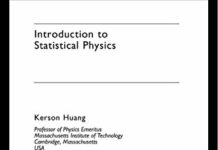
Ebook Info
- Published: 2007
- Number of pages: 285 pages
- Format: PDF
- File Size: 6.59 MB
- Authors: Kerson Huang
Description
Gauge fields are the messengers carrying signals between elementary particles, enabling them to interact with each other. Originating at the level of quarks, these basic interactions percolate upwards, through nuclear and atomic physics, through chemical and solid state physics, to make our everyday world go round. This book tells the story of gauge fields, from Maxwell’s 1860 theory of electromagnetism to the 1954 theory of Yang and Mills that underlies the Standard Model of elementary particle theory. In the course of the narration, the author introduces people and events in experimental and theoretical physics that contribute to ideas that have shaped our conception of the physical world.
User’s Reviews
Reviews from Amazon users which were colected at the time this book was published on the website:
⭐This book explains in very simple language concepts that I thought were too difficult for me to ever understand. I have a degree in mathematics but not physics. Kerson Huang must have put a lot of work into figuring out the simplest explanations. The main topic of the book is gauge invariance, both local and global, which he presents with a mixture of history, and concrete examples. Physics does indeed look much simpler when expressed in the form of gauge invariance, and he admits quite freely that it wasn’t discovered in this way. He says that all these things were worked out by a very painful, time consuming process, and it just happens that they can be explained very simply now in terms of gauge invariance. The classical equations of Maxwell allow for the introduction of gauge fields, but the charges completely ignore them. Not so in quantum mechanics, where these fields have very real effects. He gives a much simpler explanation of the Bohm-Aharonov experiment than the usual one, and explains the importance of the vector field A generally. I didn’t realize that Bohm expected the experiment to fail, thereby showing that quantum mechanics was flawed. But of course, quantum mechanics came through with flying colors, as it always has, so far.He explains the difference between global and local invariance as follows: With global invariance, if we define the electron to have negative charge on the earth, then it must have a negative charge on mars. With local invariance, it can have a positive charge on mars. But if you bring an electron from mars to the earth, it will obey the local rules and act as if it had negative charge. As quantum mechanics developed, global invariance was replaced by local invariance, and this ended the long reign of “action-at-a-distance” in physics.He presents some differential equations, because you must, but they don’t convey much to me. He explains the effect they have on the physics.I thought that fiber bundles were a very difficult concept in higher mathematics, but in the context of gauge invariance, they are actual fibers, and the meaning is concrete and easy to understand. Sometimes the pure mathematicians make things too abstract.Other tidbits:He explains the Higgs mechanism that has recently been in the news because they finally detected the Higgs particle. He also explains how it started with work by Philip Anderson on superconductivity. Superconductors repel magnetic fields–this is called the Meissner effect. In Anderson’s model, the superconducting field imparts a mass to the photons that carry the magnetic field. Because of their mass m, they can only penetrate an amount 1/m, which agrees with experiment. This model was taken up by the particle physicists, who extended it, creating a Higgs field that pervades the entire universe and gives everything mass. The Anderson-Higgs mechanism, as it is sometimes called, involves spontaneous symmetry breaking, and Professor Huang explains this in a very simple way.He also explains renormalization, and what we now know, the reason behind it.Another tidbit: In quantum mechanics, time t is related to temperature T by t = constant.iT, where i is (-1)^1/2, and says we have no idea why this is.
⭐An insightful/readable introduction to the ideas/history of gauge theories and the standard model. With just enough math to begin to make sense. Includes related ideas such as superfluids, superconductors, and S matrix theory. From almost 15 years ago, but still surprisingly up to date. UPDATE: A bridge from the introductory tapestry of people, theories, & experiments in Amir D Aczel, “Present at the Creation: Discovering the Higgs Boson”, 2012 to the detailed theory in Kerson Huang, “Quarks, Leptons, and Gauge Fields”, 2nd edition, 1992.
⭐I agree completely with the previous review, but I feel that I should add a cautionary note for the prospective purchaser. I would say that the book leans away from the typical popular-level and towards a more advanced semi-popular level, that it contains a serious, if condensed, review of the basics, and gives an advanced survey of a rather complex subject.Yes, the author explains the equations, but much would be lost that unfortunately can’t be treated in this manner. It is not a “light read.” Thus, I feel that I should give this caution for those who do not have at least an undergraduate level understanding of the pertinent mathematics and physics. This is not to frighten away the motivated reader, but just to give fair warning that at least a basic understanding of the equations is necessary to gain full value of the book.Otherwise, I give this book my highest recommendation for those interested in one of the best explanations of gauge fields and the history and individuals involved in their development that I have seen.
⭐I am just not sure who this book is actually for. As I hope you can tell from the other reviews, without an undergraduate degree in physics or mathematics, there won’t be a lot that makes sense here. After all, fiber bundles are introduced on page 39, following the sudden arrival of tensors on page 34, with nary a word of explanation as to what they actually are. But is this book really technical enough to be useful to practicing physicists and mathematicians? Is it saying anything really new to practicioners?In this case the INSIDE feature in Amazon is misleading as the first few chapters have nothing more than partial differential equations and based on that,a reader with a undergraduate engineering degree could well belive the text would be accessible enough. As I did, obviously though in error. Consequently, I cannot actually comment on the technical content of the greater part of the book.All this is not to say that the book does not have good things in it. It does, and the discussions of different people and their contributions are interesting if not particularly profound.But it is hard for me to decide to whom I would recommend this book or give it as present.
⭐Great resource for me because it assumes the reader has requisite math background and then develops the physical concepts in a simple and clear exposition. Although the text assumes familiarity with tensor calculus, Dirac Bra-Ket notations and similar math forms, the reader can pick up these concepts from Wikipedia articles. Most useful for those at entry graduate physics level but readable by most readers with only undergrad physics knowledge.
⭐This book is a sweeping overview and historical perspective of Standard-Model Physics. All interaction is based on Gauge Fields which themselves are consequences of local symmetry postulates. Some parts of the book, such as the historical background sections can be enjoyed by any reader interested in this most fundamental of all the sciences, Physics. Other parts, such as the chapter on Yang-Mills fields are best appreciated by someone who already has some basic particle physics training. I greatly enjoyed this book and its clear exposition of the fundamental concepts we currently use to make a model of reality.
Keywords
Free Download Fundamental Forces Of Nature: The Story Of Gauge Fields in PDF format
Fundamental Forces Of Nature: The Story Of Gauge Fields PDF Free Download
Download Fundamental Forces Of Nature: The Story Of Gauge Fields 2007 PDF Free
Fundamental Forces Of Nature: The Story Of Gauge Fields 2007 PDF Free Download
Download Fundamental Forces Of Nature: The Story Of Gauge Fields PDF
Free Download Ebook Fundamental Forces Of Nature: The Story Of Gauge Fields




